Barb Winters's Blog, page 2
June 16, 2025
BLAST Triggers: What’s Driving Your Teen’s Behavior?
Some run to drugs. Some shop. Some watch pornography.
How do you cope when your anxiety spirals and you’re desperate for relief? What’s your default reaction when triggered?
How about your teen? What sets them off and where do they turn?
I eat. My food of choice was ice cream until stomach problems forced me to give it up. Now it’s Ghirardelli chocolate. The dark chocolate mint squares. (Pause with me and mentally savor this treat.)
In all transparency, I also turn to social media or streaming shows. When my to-do list is out of control or I’ve failed someone close, to numb my brain and stop the incessant negative self-talk, I scroll. Or get lost in a show.
Unfortunately, after I’ve eaten the chocolate and turned the TV off, the problem remains. My list hasn’t magically disappeared, and negative thoughts quickly return.
Name the Pain and Know the PullPinpointing the outside stimuli or emotions that affect us—and our children—is key to recovery.
To overcome compulsive behavior, we must acknowledge its destructive impact and then identify the triggers that compel us to repeat it.
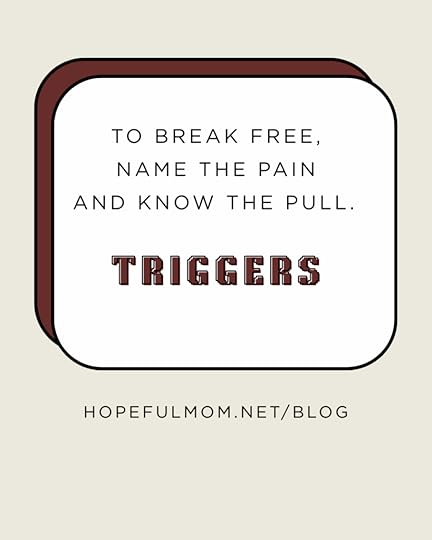 What Are BLAST Triggers?
What Are BLAST Triggers?BLAST triggers are common. This acronym stands for Bored, Lonely, Angry, Stressed, and Tired.
BoredWe are meant to be active, physically and mentally. Whether working, studying, interacting with friends, or participating in physical activities, our minds and bodies need engagement. When faced with boredom, our children could succumb to an activity they’re conditioned to believe is pleasing, entertaining, or numbing (at least momentarily).
To combat this BLAST trigger, let’s help our teens recognize when they are bored. Ask them to brainstorm a list of things to do when they’re restless. They may want to call a friend, read a book, take a walk, or learn a new hobby like painting, playing the guitar, etc.
LonelyEach of us possesses a basic need to belong. Loneliness leads to sadness, depression, or feelings of emptiness. These can trigger self-medicating behaviors like watching pornography or too much screen time.
To combat this trigger, help your child find where they fit in. Schedule family meals and activities. Include them in discussions. Encourage them to try various after school organizations, sports, or clubs.
AngryAnger instigates irresponsible behavior. When we don’t have healthy methods of dealing with anger, we cope by turning to our vice of choice.
To combat this trigger, help your child identify who they are angry with and why. Then encourage them to forgive and learn methods to diffuse their anger.
Re-direct your child toward a productive pursuit when they feel agitated.
Pinpointing the outside stimuli or emotions that trigger us—and our children—is key to overcoming addiction or compulsive behaviors. BLAST Triggers: What’s Driving Your Teen’s Behavior? #triggers #hopefulmom #parenting
Share on X
We experience an extreme amount of internal and external pressure to perform at a certain level, to behave a particular way, and to fit in with peers. This causes stress. Our instinct is to find a quick way out of the anxious situation—to calm our nerves and ease our discomfort. Unfortunately, many of these coping mechanisms are only temporary fixes and do not address the underlying issue.
To combat this trigger, help your teen understand normal levels of stress and teach them anxiety-reducing strategies like breathing exercises.
TiredOur brains don’t function well when we’re tired. We make irrational and illogical decisions. Someone who is tired may turn to drugs, alcohol, or pornography, believing this will relax their body and help them sleep.
To combat this trigger, help your teen understand the importance of proper sleep. They need 8-10 hours of uninterrupted (no tech in bedrooms!) sleep. For more information on helping your teen sleep better, read Teenagers and Sleep: How Much Sleep is Enough?.
Other TriggersBesides the above-named BLAST triggers, hunger or reminiscent situations may provoke a desire to turn to a vice. Other acronyms for triggers are HALT and SEE.
Hungry
Angry
Lonely
Tired
Social – certain people or situations or feeling peer pressure
Environmental – sights or sounds
Emotional – feelings, like rejected or hurt
Create A PlanWhether its BLAST triggers or others, learn to pause, name the offensive element, and choose a healthy and effective response.
When craving a Ghirardelli, I ask myself if I’m angry, stressed, hurt, or bored. If the answer is yes, I stop to evaluate what happened and (usually) choose to work through the presenting problem rather than drown my sorrow with chocolate.
Healthy responses may take a while to come naturally, but I believe you and your teen can devise a plan to combat triggers effectively.
For specific questions to discern your child’s triggers and more information on combatting triggers, read Understanding Triggers in Pornography Use. For a list of possible trigger-inducing events for parents of a child who’s been exposed to pornography, read Parent Triggers After A Child’s Pornography Exposure.
The above was adapted from a section in Chapter 7 of the book, Sexpectations: Helping the Next Generation Navigate Healthy Relationships.
Note: Sometimes counseling is necessary to overcome compulsive behaviors or addictions.
The post BLAST Triggers: What’s Driving Your Teen’s Behavior? appeared first on HOPEFUL MOM.
June 2, 2025
Yes, Your Child is Being Targeted by Online Predators
I met Kimberly Ells, our guest author, through the Safeguard Alliance and was impressed by her passion to help families. She’s a policy advisor and has spoken at the UN. Her passion for keeping kids safe from online predators shines through in this piece.
For many parents, the day they find out their child is being approached, targeted, educated, and manipulated by strangers on his or her digital devices is the day they finally take seriously all the warnings and admonitions about phone and digital device use they have heard for years. By that time, often great damage has been done. It is never too late to take action to protect your child but the sooner you do so, the less damage will be done.
"It's never too late to take action to protect your child." Kimberly Ells – Yes, Your Child is Being Targeted by Online Predators #mentalhealth #humantrafficking #parenting
Share on X
If you think that digital abuse, moral deprogramming, transgender grooming, porn addiction, or even trafficking can’t happen to your child (because your child comes from a good family, or your child is smarter than that, or you’ve already warned them about digital dangers) you’re wrong.
Here are three real examples from good families with smart kids who talked about digital dangers together and still faced serious digital entanglement and danger.
JennaJenna needed an iPad to do some of her junior high school homework on. Her parents got her one and discussed basic digital safely with her. At first, they made sure it was used sparingly and put away every night. Over time, the presence of the iPad became normal, and her parents forgot to stow it at night. Jenna began taking it with her into her room at night. She encountered increasingly dark and disturbing content on it. She continued to consume this content, even though she wasn’t sure why she was doing it, and over time she became increasingly despondent, irritable, and sad.
Her mother finally noted the difference in Jenna and asked her about it. By this point Jenna was experiencing suicidal thoughts. She told her mom about the iPad and everything she’d been accessing on it as well as her feelings of despair. Jenna’s distress was so acute that her parents got her into a trusted therapist who could help her emerge from the dark place she had descended into. The other thing they did was remove the iPad entirely except for times when they could sit down with Jenna and use it for specific school assignments. What was Jenna’s response when they took away the iPad? Relief. She expressed profound relief at having the device—and its influence over her—removed.
NikkiNikki got a smartphone when she was sixteen. She began to do harmless searches for things teenage girls might be interested in, such as, “What do boys like?” The content was innocent at first but quickly became erotic. Before long, Nikki was saturated in sexual content and was being told by numerous sources that engaging in extreme sexual behaviors with boys was normal and expected. Before long she was being approached digitally by older boys and men who were interested in her sexually. She liked the attention she was getting, so she joined a dating app (lying about her age so she could do so).
Encouraged by the continued attention she got on the app, she began leaving her home in the middle of the night to meet men in their 20s and engage in sexual acts. By the time her parents became aware of the situation, she was one step away from being sucked down the road to sex trafficking by a man who was pretending to be romantically interested in her.
OliviaOlivia downloaded the Snapchat app on her phone to connect with her friends even though it was against her parents’ rule. She did connect with friends, but strangers immediately began to reach out to her. Within only a few messages, some of these strangers began telling her they had seen pictures of her, how beautiful she was, and that they would like to perpetrate sexual acts on her. They began describing the acts in detail and when she showed surprise, one of the men expressed how much he loved being the one to expose inexperienced girls to depraved acts.
The girl found the interaction disturbing—but also somewhat intriguing—and allowed it to continue. She realized she wanted it to end but didn’t know how to extricate herself from the situation. Thankfully, she did something smart: She showed her mom the messages. Her mom told her that she should immediately stop the conversation, delete the app, and not return to it.
The Radical and Unthinkable ThingThere is much to be said about these three examples, but I will point out only two things. First, in all these cases, if the parents had not given the child independent access to a digital device, none of these disturbing events would have occurred. Second, in every case, it was the parents who helped extricate the child from adverse and dangerous situations.
That being the case, we must ask ourselves why we are putting our children in digital situations from which we must rescue them. Some argue that kids just need to learn to deal with the rigors of phone use. But are children really prepared to do so? Should we expect 12-year-olds or even 16-year-olds to be able to navigate sexually charged situations with manipulative predators?
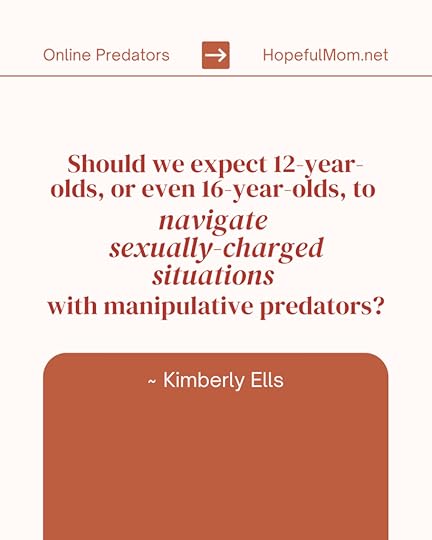
I am going to suggest something radical and even unthinkable to many parents: Do not give your child a fully internet-enabled phone. And do not give them any other digital device that gives them unfettered access to the internet. Simply do not do it. Don’t wait until your child is the subject of a sad story like the ones above (or one much worse) before you proactively work to protect your child.
If you have given (or are considering giving) your child or teenager an internet-enabled phone to keep them safe (while driving or to track where they are, etc.) ask yourself what you are trying to keep them safe from. The dangers of possessing a phone may outweigh the dangers of not possessing one.
A phone is not only a portal for a child to access the entire world, it is also a portal for the world—and dangerous people in it—to access your child. And they are eager to do so.
Don’t let them.
NOTE from Barb: Check out the Gabb phone here as an alternative to a Smart phone.
Subscribe to Hopeful Mom for two FREE PDF downloads, keep up with Hopeful Mom on Facebook, Instagram, and LinkedIn, and check out Barb’s book Sexpectations here.
The post Yes, Your Child is Being Targeted by Online Predators appeared first on HOPEFUL MOM.
May 5, 2025
Quitting Social Media Transformed My Daughter’s Mental Health
It’s a privilege to welcome back Jessica Brodie as our guest author. She cares for those struggling with mental health. I love her thoughts and advice concerning teens, social media, and mental health. Jessica’s debut book released last month. Find it here.
It started slowly at first, sneaking up on me. My confident, boss-lady daughter struggled with anxiety and panic attacks for years, but she was still self-assured and likable, and she still seemed to like herself.
Then puberty hit, and with it, the pandemic. About that same time, she’d reached the age where it seemed OK to let her have a cell phone—carefully moderated, of course, with all the requisite parental controls, privacy restrictions, and other important instructions, like “no direct messaging” and “don’t give out your personal info.” I didn’t think it was a problem to let her get TikTok and Instagram as long as her accounts were private.
But then I noticed a change in her clothing. She wanted her tops a little more cropped and her jeans a little more snug. She spent more time looking in the mirror, posing for an invisible audience. We started having tension about what kind of clothes were appropriate for her to wear, what kind of pictures were appropriate to take and post online, what kind of dances she was learning on some of the new apps.
Then she became weight conscious, eating less at meals and sometimes insisting she just wasn’t hungry. She begged me to let her get highlights in her hair and acrylic nails.
"My once confident daughter struggled with anxiety and panic attacks because of social media." Jessica Brodie tells us why her daughter quit and offers parents tips. Quitting Social Media Transformed My Daughter’s Mental Health…
Share on X
I didn’t see the impact social media was having on her self-esteem, her worldview, her perspective, or her mental health.
In retrospect, I would’ve done things far differently, but I didn’t know. Most of us don’t know.
“I don’t want to shelter her. I want to give her room to make mistakes in a safe environment,” I rationalized. “I want to raise her in a godly and Christian way, but with enough freedom that when she gets old enough to go out in the world, she’ll know how to make good choices.”
I thought a little social media usage wasn’t a big deal.I didn’t understand back then the power social media had to influence my sweet daughter, to lure her into new and dangerous thought patterns. I didn’t realize other dangers she was exposed to just by being on these apps.
Soon she was comparing herself nonstop. If she wasn’t trying to imitate what she saw online, she was lamenting that her life didn’t look like other people’s lives—we didn’t have a boat, we didn’t go on vacations to tropical islands like “all her friends.” Mind you, I knew her friends, and I knew none of them had boats or vacationed on tropical islands.
All of this came from what she saw other girls her age posting on social media.
And it did a number on her self-esteem and her mental health during a time when she was already struggling with depression and anxiety. It became a perfect storm that crashed violently all at once, and it took years to get her healthy again.
The DecisionI wish I could say I wised up, but it was my daughter who finally suggested she delete all social media from her phone and close her accounts.
A week later, I noticed a difference. She seemed happier in her own skin, not nearly as moody or volatile. Two weeks later, I saw even more improvement.
Since then, we’ve done experiments. She’s a few years older now, and we’re starting to look at colleges. A couple of times over the years we’ve decided to experiment and let her get Instagram again. Yet after just a few days, we can all see a big difference in her mood and her level of comparing herself to others. She can see it, too. And so we delete the app once more, and all becomes well again.
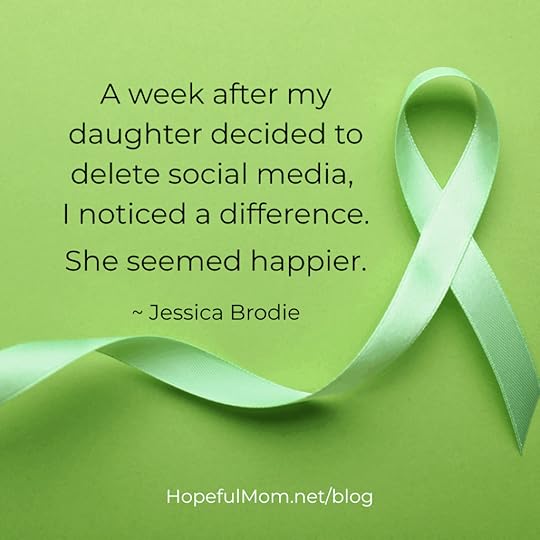 The Comparison Game
The Comparison GameComparison is good for none of us. We look at other people and think what we see is reality. We see someone sharing about their seemingly perfect life, and we don’t know that two feet away there’s a mess in their kitchen because all we see is the clutter-free camera-worthy area behind them. We don’t see that someone was able to afford that fancy vacation by maxing out their credit cards. We don’t know the pain it took them to get to this place in life. We don’t know the whole story.
Instead, we look at other people’s lives and sometimes feel badly about our own. We wonder why we don’t have this or that, or why we are not at this place in our own lives.
Imagine the impact it has on a young and impressionable girl who is still trying to figure out her own identity. Imagine all the lies being fed into her soul as she struggles to understand the difference between truth and fiction and her own place in this world.
Yes, I know the world is increasingly online. And I know there are beautiful aspects of social media.
But in our house, for our family, it’s drastically limited. It had a hugely negative effect on my daughter, and it took me far too long to recognize it.
Banning social media is not for every family. But if you are reading this and have been feeling a nudge from God, maybe this is your answer, like it was ours.
Here are a few tips that might help:Talk openly with your teen. Tell them why you’re concerned or want to do this. Genuine reasons speak volumes.Propose a social media vacation or break for a week or two to experiment with or assess how they feel without it.Establish ground rules and use parental control settings. Typically the parent owns the phone and is the account holder on the plan, so it’s your right to take control if your child lives under your roof.Remember that even if it seems like the whole world is on social media, they’re not. As Christians, we’re called to be different and not like the world.Help your child find alternatives to spending time on social media, such as reading, exercise, or connecting with people in real life.Model the behavior yourself.Understand that kids can access most social media from a website, even if they don’t have an app. They can also create a secret account and block you from being able to view it.Try it and see what happens. Try it even if your child doesn’t take the lead like my daughter did—even if you look like the “bad guy.” You might find it is an answered prayer and a solution that on its surface seems way too simple but in reality is the very thing you need.
Please subscribe to Hopeful Mom for two FREE PDF downloads: 7 Steps After Your Child Sees Porn AND Sexpectations Reflection Questions. For information on modeling habits of healthy relationships, read Sexpectations: Helping the Next Generation Navigate Healthy Relationships.
The post Quitting Social Media Transformed My Daughter’s Mental Health appeared first on HOPEFUL MOM.
April 21, 2025
What Netflix Show Adolescence Reveals About Teen Mental Health and Technology
Information about the Netflix series Adolescence filled my feed, but I resisted the urge to turn it on. I ignored the ads and scrolled past the comments. I didn’t want to watch.
My research can affect my mental health to the point that I must step away. When that happens, I view uplifting, positive, or humorous content. I press pause on social media and all things mentally exhausting or downright sad.
But after seeing post after post about the new record-breaking Netflix series Adolescence, I relented. Accounts I trust claimed the show was impactful and that the storyline mirrors what our teens face every day.
I finally watched Adolescence after reading this quote from Nicki Reisberg of Scrolling2Death:
Is Adolescence Appropriate for You or Your Teen?“From what I’ve seen, the film is an accurate representation of what can and is happening to the underdeveloped brains of children when they are pushed addictive and harmful algorithms … It’s true that kids alone in their room with technology can be the most dangerous place in the world. … The bad stuff keeps the kids scrolling longer.”
In my opinion, this is a brilliant show. The filming, acting, and music are excellent. But that doesn’t mean it’s for everyone.
Before you watch, a few warnings—thanks to Andrea Davis of Better Screen Time.
Content: Adolescence is rated TV-MA (intended for adults). The show contains violence, sexual references, and an excessive number of f-bombs. Please follow your family’s media standards and don’t feel obligated to watch this show.
Realistic but Fictional: While the plot could be real, it’s a fictional representation of teen life.
Viewing this show isn’t necessary: The film offers a haunting insight into what our kids are up against, but it isn’t the only way to learn about these dangers. This alternative video explains dangers our children encounter and offers solutions: Our Kids Online: Porn, Predators, and How to Keep Them Safe.
That said, this series is emotionally intense with heavy themes. It offers a powerful window into what our teenagers deal with in the digital age. Many preteens and teens walk this same road, silently, while we go about our lives thinking they’re “just on their phones.”
What Adolescence Exposes About Teen Mental HealthThis film doesn’t just explore the dark corners of the internet—it shines a spotlight on real-life issues:
Bullying and RejectionPornographySending NudesThe Manosphere and Toxic MasculinitySocial Media PressureIsolation Caused by Tech in BedroomsThe narrative follows a seemingly average teen boy from a loving home. His parents aren’t villains. Their choices are like many of ours: giving their son access to tech, trusting his judgment, and allowing devices in his room.
But even good kids from good homes can spiral when left alone with an internet built to exploit their insecurities. Let’s recognize the battlefield they’re navigating so we can fight back.
Message for AdultsAdolescence isn’t just about preteens and teens. The adults around the kids didn’t grasp the immense influence the screens had until it was too late.
The Netflix series Adolescence begs us to listen to our children. When they say school is hard, pay attention. When they withdraw, don’t dismiss the behavior as “teen angst.” When they open up, engage.
Educate and communicate. The following posts may be helpful:
Why Educate Your Child About Porn
What Parents Need to Know About Sextortion
Tech in bedrooms isn't safe. Netflix Adolescence shows why. Here’s what the show got right—and what we need to do as parents. What Netflix Adolescence Reveals About Teen Mental Health & Tech #DigitalParenting #ScreenTime
Share on X
1. Make Bedrooms Tech-Free Zones
Sleep and solitude should be protected spaces, not gateways to dangerous content. Removing screens from bedrooms reduces late-night scrolling, exposure to harmful content, and emotional dysregulation.
2. Talk to Your Kids About the Pressures They Face
Many teens struggle in silence, overwhelmed by rejection, confusion about femininity and masculinity, and the constant comparison game of social media. Create space for open, ongoing conversations.
3. Call Out the Toxic Content
The manosphere is more than just edgy commentary—it’s a pipeline into misogyny, entitlement, and harmful worldviews. Equip your child to recognize it and critically question what they see. The manosphere and online pornography aren’t “harmless phases.” They shape how young men (and women) view themselves, women, and relationships. Let’s bring these topics into the light and teach them to question what they’re consuming.
4. Mentor and Monitor
Parenting in the digital age isn’t about spying. It’s about guiding. Teach your child how to use tech intentionally, recognize manipulation, and set healthy boundaries.
5. Model What You Preach
Your tech habits set the tone. If you’re always on your phone, expect resistance when you ask them to log off. Show them what digital discipline looks like.
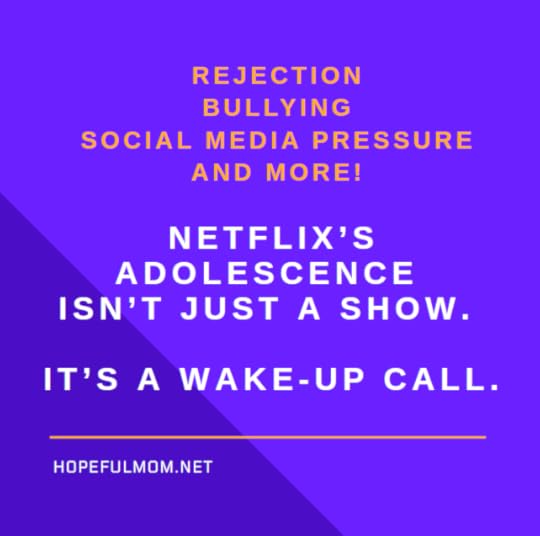 We Can’t Afford to Look Away
We Can’t Afford to Look AwayIn the end, Netflix ’s Adolescence isn’t just a show. It’s a wake-up call. Not one meant to shame parents—but to urge us toward a more conscious, connected way of raising our children.
Yes, it’s heavy. But sometimes heavy stories are exactly what we need to help us understand the weight of our responsibilities. So, even if you choose not to watch the show, heed the message.
Let’s not wait for a crisis to start the conversation. Your child’s mental health and future are worth every uncomfortable moment.
Please subscribe to Hopeful Mom for two FREE PDF downloads: 7 Steps After Your Child Sees Porn AND Sexpectations Reflection Questions. For information on modeling habits of healthy relationships, read Sexpectations: Helping the Next Generation Navigate Healthy Relationships.
The post What Netflix Show Adolescence Reveals About Teen Mental Health and Technology appeared first on HOPEFUL MOM.
April 7, 2025
5 Steps to Talk to Your Kids About Porn
Greta Eskridge is here! What a privilege! Greta’s recently released book, It’s Time to Talk To Your Kids About Porn, quickly became a best seller. Her topic is timely and essential. And, like most of you who’ve been here at Hopeful Mom know, one I’m passionate about. I recommend Greta’s book and listening to our discussion How Do I Respond When My Child Sees Porn? on her podcast. For those who’ve learned their child has seen pornography, I recommend the following downloadable booklets in the My Child Saw Porn series: You Are Not Alone and What Do I Do Now? And please be sure to subscribe for the FREE PDF: 7 Steps After Your Child Sees Porn.
The LORD is close to the brokenhearted and saves those who are crushed in spirit. —Psalm 34:18
It’s what every parent dreads and the message I get every week: “My child has been exposed to pornography. I feel sick. I am devastated. What do I do?” The details vary—confessed or discovered, accidental exposure or sought out, at a friend’s house or at home, younger child or older teen, on an unlocked device or fully protected one—but the end result is always the same: devastated, heartbroken parents and a struggling child.
This doesn’t have to be the end of the story. There is hope and healing available for your child, and it starts with you. Your posture in this moment makes a tremendous difference in how your child will process this event.
Above all, please remember that while the discovery of porn exposure or porn use hurts our hearts, God can use us to bring healing and comfort to our child whose heart is also hurting.
1. PROCESS YOUR OWN EMOTIONSThe first thing to understand is that it is absolutely normal for you to experience a cascade of different and intense emotions. Those emotions are valid and do not make you a bad parent. It’s also important to remember the words of Psalm 34:18: “The LORD is close to the brokenhearted and saves those who are crushed in spirit.” God cares about your heart and your child – He cares even more than you do.
That’s why, in the wake of discovery, you need to summon every ounce of self-control, compassion, love, and grace from the Holy Spirit to pour out on your child. You want to offer shame-free warmth and care. Make sure they know that they are not in trouble. There’s time later to talk about new boundaries and guardrails, but not now. Now is the time to be near your child both physically and emotionally.
2. CONNECT WITH THEMAfter confession or discovery, if your child is open to it, hug them, hold them, or at least be physically near to them. Your job is to help them feel safe, peaceful, and even happy again. Pray together that God can take the pictures out of their mind and bring them healing. That should be the whole of the first conversation. It is not the right time for a lengthy lecture or even conversation. Be loving and be brief.
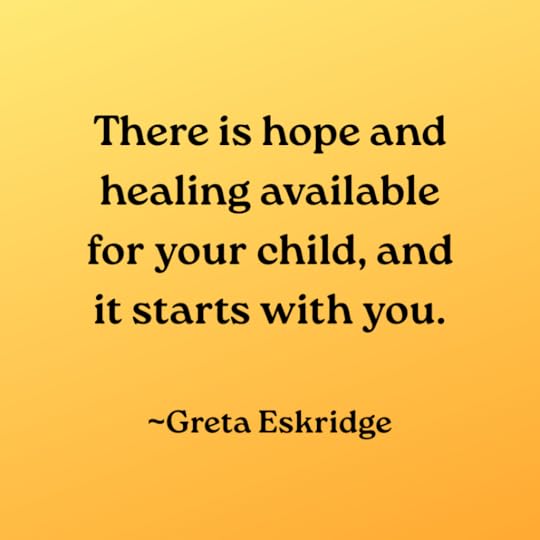 3. TAKE TIME TO PREPARE FOR THE CONVERSATION
3. TAKE TIME TO PREPARE FOR THE CONVERSATION The reason it is ideal to wait for the next conversation is because it is going to be more awkward and potentially painful. You need to determine the extent of your child’s exposure. If they confessed to you, you’ll be asking questions to see if this was a one-time viewing or if they went back to see more. If possible you’ll want to look at the history of the device used to get a clear picture of the trauma your child might be walking through based on what they saw.
If your child didn’t come to you and you made the discovery, chances are you already know what they saw. But it’s still important to find out how long they have been viewing pornography, where, etc. It’s also helpful to encourage them to share with you if they can, as this helps release some of the pain and guilt and shame they are dealing with. Reassure your child that your questions are for their healing and safety, not because they are in trouble.
4. APPROACH THE CONVERSATION WITH KINDNESSIf your child is old enough to know that pornography and sex are connected, you need to let them know that pornography is not how God designed sex to be. You can tell them that God designed sex to be safe, loving, and in the context of marriage. This is not what they saw, and they need you to help them know the truth. Your child might be filled with remorse and willing to talk and confess. He might be confused. It is common for younger adolescents and children to say they don’t know why they went back to look at the pictures and videos.
For an older child, especially one who didn’t confess but was caught, you might face more anger and sullenness or less willingness to talk. This is normal, and that child needs compassion just as much as the one who willingly confesses everything. Wherever your child falls on this spectrum, try to get as much information from them as possible, check devices if you can, pray together again, and save the next part of this ongoing conversation for later.
When talking with your children about pornography, Greta Eskridge says to approach the conversation with kindness. Read here for more. 5 Steps to Talk to Your Kids About Porn #fightthenewdrug #onlinesafety #parenting
Share on X
The next talk you need to have with your child is about the steps you’ll be taking to keep them safe from further pornography exposure. Explain you must change the rules with devices in your home to keep them safe.
Now is the time to change passwords, turn on all the parental controls, and only allow them to use tech with supervision. If they were seeking out porn, consider installing monitoring software like Bark and accountability software like Covenant Eyes on all family-owned devices.
For some kids these changes will be a relief. For others it will feel like a punishment. You’ll have to stand your ground and do what is best for your child in the long run. Look for all the ways your child could get online, such as video game consoles, old phones, computers, and tablets. Clear your house of those things to protect your child.
Finally, it is time to begin filling your child’s mind, heart, and life with the antidote to the evil they consumed. Spend the next days, weeks, and months filling their mind with all kinds of good things to help replace the bad.
Read beautiful and wholesome stories and picture books together. Fill your house with hymns and worship music. Read and memorize Scripture together. Start with 2 Corinthians 5:17: “Therefore, if anyone is in Christ, the new creation has come: The old has gone, the new is here!” Write Scripture on cards and put them all over your house. Spend time outdoors as often as possible.Be with friends who bring joy and delight to your child’s life. Make extra effort to cultivate connection with your child and to provide opportunities for them to connect to God, his creation, and his people.Also consider if your child needs help beyond what you can offer. If they were accidentally exposed to pornography and did not continue to seek it out, you are probably capable of helping them heal. But if your child was actively using porn for a time and especially if they did not confess and were discovered, you might want to get them extra support from a pastor or counselor.
It is tempting to give into despair when walking through this situation. But you are not alone. So many other parents have walked the exact same road.
There is so much fear and shame attached to pornography that few parents are talking about it. But we need to band together to create a safer, more supportive world for our kids and for one another. Seeing porn is not to be the end of your child’s story.
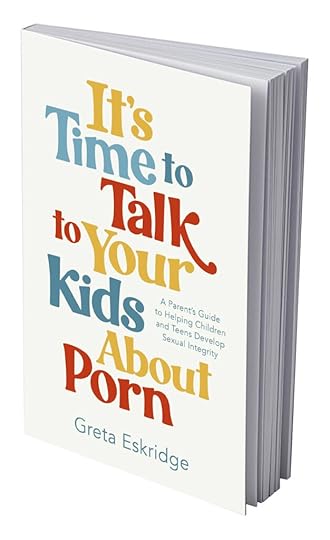
Adapted from It’s Time to Talk to Your Kids About Porn. Copyright © 2025 by Greta Eskridge. Published by Thomas Nelson. Available wherever books are sold.
The post 5 Steps to Talk to Your Kids About Porn appeared first on HOPEFUL MOM.
March 17, 2025
You’re Making a Difference!
International Women’s Day is in March. To be honest, I didn’t know that was a thing until recently. I received an email from Defend Young Minds, an organization devoted to developing tools to help raise screen-smart kids, saying they “wanted to recognize the amazing women leading the charge in child safety, advocacy, and education.” They listed me as one of the 20 Inspiring Women Dedicated to Making Life Safer for Kids. They thanked me for the impact I’m making in this space.
My jaw hit the floor. Really. Because, while I know Kristen Jenson, Best Seller Good Pictures, Bad Pictures and Founder of Defend Young Minds, her influence is far, far (far!) greater than mine. And when I read the list of women, I saw pioneers who paved the way for people like me. They lead the charge against big corporations. They fly to Washington DC to lobby for our children’s safety. They make a difference!
I hadn’t thought of myself as one of those women. One dedicated to making life safer for kids.
But I am.
And so are you.
Okay, I know men are here, too. But if you’ve taken the time to read an article, purchase a book, soak up information, and then have just one conversation with a child, grandchild, neighbor, or friend, you’re doing it! You’re making a difference. If you added a Wi-Fi filter, monitored screen time, or used parental controls, you’re making a difference. Yes, you!
Just a MomMost of you know my story. I’m just a mom. A mom who found out her son had been watching pornography. A mom who didn’t know her child could or would access such things. A mom devastated, guilt-ridden, ashamed. Then, from love, this mom resolved to help her son.
We walked through the recovery process together. His determination and faith coupled with my encouragement and reassurance—and a host of others praying and supporting. Not easy. Not short. But effective. Freedom.
And, in the midst, a still small voice said, “Tell others. Be available to other moms. To hurting parents. Tell them they are not alone.” So I did. And I do. That’s all.
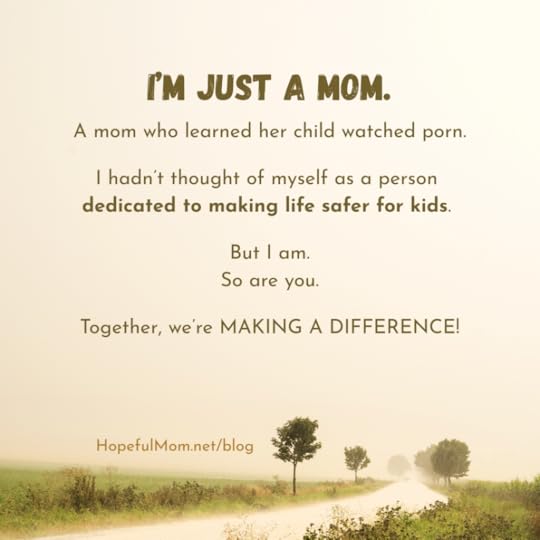 The Real Success Story
The Real Success StoryThe real success story is you. You are the one making a difference. Your hard work and dedication to keeping your children safe is an inspiration. To me.
I can’t tell you how often your stories motivate me. How your willingness to get in the trenches with your children melts my heart.
Parenting is full of ups and downs. So many times, we think we failed. We know we failed. We see the scrapes and bruises, the wrong choices and repercussions. And we ache. We talk, beg, and plead. We cry out to God. Then we loosen the grip we’ve had on the precious child we once cradled in our arms. Sometimes they wallow in their unhealthy choices. And sometimes . . . they see the destructive path they’re walking, turn, and choose a healthier route. And we rejoice.
And when we are on this journey, we should rejoice, often, over both small and large decisions. That awkward first conversation in which all blushed and stammered. That first major decision to delete social media. The instance in which our child confessed to slipping. When we held the line after their instinctive nature emerged once again. And, of course, when they held fast to their goals, resisting their urges.
Today, I celebrate you. A mom. A dad. A grandparent. A community leader. A pastor. An influencer over youth. You are my inspiration. The reason I keep talking.
I’m patting you on the back for your desire to keep children safe and your diligence in researching, talking, and changing the climate. One small decision at a time. May this inspire you to keep talking!
If you’ve found help or hope here, please subscribe to Hopeful Mom and share this post with your friends.
The post You’re Making a Difference! appeared first on HOPEFUL MOM.
March 3, 2025
What Screens Aren’t Teaching
What important life skills are our children not being taught by screens? My friend, Christy Bass Adams, answers that question in this guest post. Christy’s compassionate heart comes through in this message to parents and those of us who spend a significant amount of time on our screens.
Our church recently hosted a workshop entitled, Are You the Screen Hero Your Child Needs? with speaker Barb Winters. She shared the dangers of unmonitored online access to kids and teens and the unhealthy habits and dynamics created in their lives. She also highlighted dangers and possible predators waiting to devour our children.
It’s easy to write these things off, especially when we are distracted or singularly focused. We need our kids quiet and entertained, so we put screens in front of them. They eat breakfast, lunch, and supper in front of screens. Everything revolves around keeping them entertained and engaged. Who actually knows what their minds are taking in?
What does this teach our kids?
More importantly, what are screens not teaching them?SocializationDr. Sawchuk, from Mayo Clinic, says, “We are social animals by nature, so we tend to function better when we’re in a community and being around others.”[i] Depression and loneliness are more apt to enter a person’s life who has neglected socializing with others. The benefits of socializing include a better memory, sharper cognitive skills, a general sense of increased happiness, and is thought to lead to longer life as well.[ii] Kids, teenagers, and adults hiding behind screens, aren’t interacting with people face to face as often. Mindless video scrolling, text conversations with abbreviations and partial sentences, and unmonitored access to content that is not age appropriate is creating a generation that not only doesn’t socialize as much, but is forgetting how.
ConversationWhen asked about the effects of technology on modern day conversation, sociology professor Sherry Turkle responded, “Conversation is the most human and humanizing thing that we do. It’s where empathy is born, where intimacy is born—because of eye contact, because we can hear the tones of another person’s voice, sense their body movements, sense their presence. It’s where we learn about other people.”[iii]
Even fifteen years ago when I was in the elementary classroom, I noticed the effects of technology. I regularly engaged my fourth and fifth graders in activities requiring conversation with peers—asking questions, responding appropriately, and utilizing manners, etiquette, and respectful responses. The further development of technology and the “need” to give our kids handheld devices at younger ages is only creating a bigger gap that we as a society need to bridge.
RelationshipsMore and more people turn to technology to meet friends, dates, and long-term relationships. Texting happens first, often for weeks. Then, finally, a phone call. Some relationships remain text and reel-focused, and in-person interactions are limited. Referencing Professor Turkle about her take on conversation, these technological interactions are lacking body language, tone of voice, eye contact, and I’ll add, familiar humor and friendly touch. While there are some success stories, technologically focused relationships generally miss the depth, intimacy, and familiarity of in-person connection.
What are screens not teaching our children? Socialization. Conversation. Imagination. Creativity. Critical thinking. Love of nature. Relationships. Rest. Stillness. Calm. Patience. ~ Christy Bass Adams What Are We Teaching Them?…
Share on X
I remember the days when kids played outside. We raced bikes, climbed trees, built forts, jumped out of swings, and ran up and down metal slides. We lay in the grass identifying different shapes and creatures in the clouds. We watched for shooting stars. And sat around campfires telling made up stories or singing silly songs. Life was about interaction. Imagination. Creativity. And thinking critically.
If a ball got stuck in the neighbor’s tree, we found a way to get it out. If there was something on the highest shelf, we used our brains and strategically retrieved it. When we chatted with friends, we were at the edge of the neighborhood deciding which route to take, not talking through technology.
Screens have changed things. Kids don’t have to imagine the fantasy worlds anymore; everything is at their fingertips. They speak it, AI generates it. While technology has created ease of access, I fear for the future generation’s ability to play, create, imagine, and problem solve. Not to mention the ability to count back change if the computers go down at a restaurant.
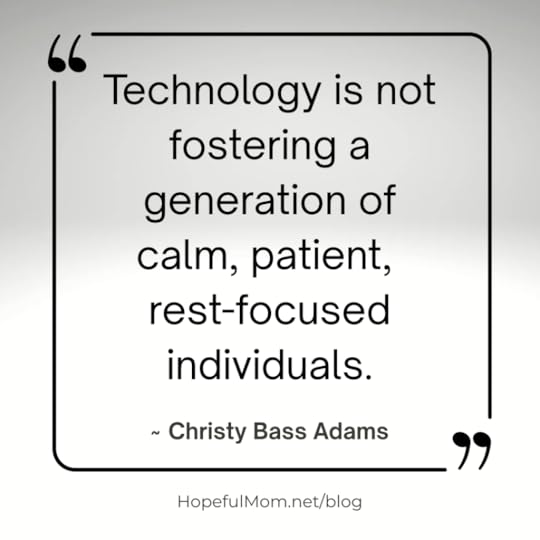 Rest, Stillness, Calm, and Patience
Rest, Stillness, Calm, and PatienceAnything a person wants or needs is at their fingertips. While fast food and processed packages changed my generation, the fast-paced, instant gratification of the internet has changed this one. Smartphones, tablets, smartwatches, Fitbits, self-driving cars, Uber-Eats. Technology is not fostering a generation of calm, patient, rest-focused individuals. They’re rarely still physically and constantly entertained with technology.
This generation is being educated, entertained, and raised by screens. And sadly, we are their models. No more book or magazine reading in doctor’s offices. Very few handwritten notes or cards. Audible car games and conversations are obsolete.
ChallengeWe have allowed this to happen. Because our noses are always in a screen.
I’m guilty. My phone is my calendar, alarm, connection to friends and family, entertainment, and security. Its buzz interrupts meaningful activities and takes precedence over whatever I’m doing. And what do we do on our phones? Scroll through pointless reels, spy on people through social media, check messages, and play ridiculous games. There are important things as well, but overall, our phones keep us engaged in a virtual world and pull us away from real people.
I’m challenging myself to do better. Text messages can wait. Emails will be there later. The people in the room are the ones that matter most, and they need to be the ones who get and keep my attention.
Will you join me? Will you make a conscious effort to be present? Silence the noise of senseless media? Will you teach your kids to be present and engage with those in the room as well? If we don’t, we will lose this generation.
Be sure to visit Christy’s website at christybassadams.com and check out her books here. Subscribe for Hopeful Mom updates, share this post, and peruse the Hopeful Mom resource page. Thanks for reading!
[i] Mayo Clinic Minute: The benefits of being socially connected – Mayo Clinic News Network
[ii] Mayo Clinic Minute: The benefits of being socially connected – Mayo Clinic News Network
[iii] How Smartphones Are Killing Conversation
The post What Screens Aren’t Teaching appeared first on HOPEFUL MOM.
February 17, 2025
The Impact of Betrayal Trauma on Parents
Healthy relationships thrive on trust. When one person betrays the other, that trust breaks and the relationship’s solid foundation crumbles. Betrayal trauma may follow.
Several years into my son’s ordeal, I read about the effects of betrayal trauma in Dr. Sheri Keffer’s book Intimate Deception. She states, “Trauma is a reaction of our bodies, minds, and emotions to a deeply distressing event. . . . Like a death, earthquake, or car crash, the event happens suddenly and changes us without warning, causing us to feel shock, denial, agony, terror, or helplessness.” Keffer explains that these reactions can be ongoing if the deception (betrayal) is ongoing.[i]
The description rang true. I can’t enumerate all the ramifications of my son’s deceit, but I remember the sting of being lied to. At the time, I could not have imagined this child ever lying to me.
So easily.
Over and over.
Without a hint of deception.
My son’s betrayal was more devastating than his pornography use. I was undone.
Typically, betrayal trauma is associated with an intimate partner relationship. However, a child’s consistent dishonesty and disloyalty produces similar effects in a parent/child relationship. The result is psychological and emotional distress which can seep into all areas of life.
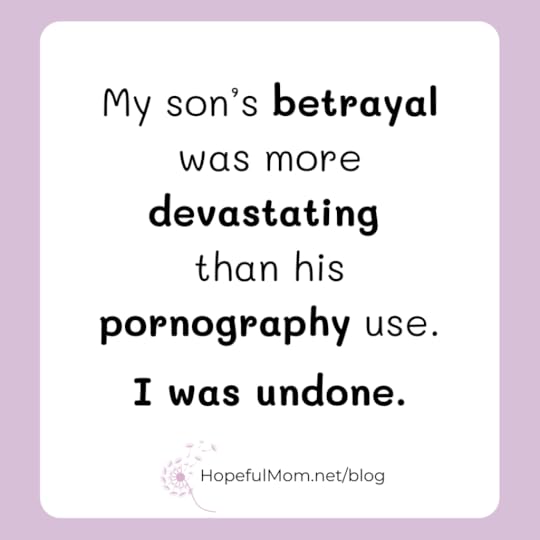 Impacts
ImpactsMy son had deceived me—in a sense, had been disloyal to me—for years. Yes, his porn use and other deceptive behavior impacted how I interacted with him. I no longer trusted him. But the ripple effects of the betrayal trauma I experienced touched other aspects of my life also.
Our home atmosphere changed. A secret loomed in the air and the tension was noticeable. I questioned my other children’s statements and wondered if they were lying too.
The trauma affected the connection I shared with my husband. Some days it drew us closer, whereas other days it drove a wedge between us. We agreed on treatment for our son, but the emotional strain seeped into our marriage through other avenues.
The effects changed how I interacted socially with friends and extended family. I usually talked openly about my parenting shortcomings and victories. However, in this area of life, I couldn’t share details—or even offer a broad overview. I felt like a fraud.
The situation impacted my intellect. My thinking was clouded, and my emotions were poised, ready to seize my brain at a moment’s notice. I forgot why I entered a room or the chore I was trying to complete. I couldn’t remember simple things, like where we kept the forks. I was forced to stop, close my eyes, and focus on normal, everyday tasks.
Our finances were affected as we began paying for filters and other resources.
The ordeal infringed on my physical well-being. My anxiety spiked, and I teetered between bingeing on sugary snacks and eating nothing at all. Sleep was elusive, my mood unstable, and my sensitivity heightened. I wavered between numbness and breaking down. The stress was overwhelming.
The betrayal trauma influenced my relationship with God. I threw questions in anger at Him one day and put my head in His lap and cried like a baby the next. Thankfully, His steadiness was one constant in my turbulent life. His strength empowered me to keep going, to get out of bed each morning, and to continue parenting my child. His love propelled me to keep loving, to plug away, to stick it out.
He quieted my fears.
A child's lying and deceiving may lead to a parent suffering from betrayal trauma. This can affect all areas of life, including their close relationships, intellect, and physical well-being. The Impact of Betrayal Trauma on Parents…
Share on X
Are you feeling the effects of betrayal trauma? Are you stunned by your child’s deception and lying? Is your relationship with your child damaged? Are you now struggling to trust others? Have the effects seeped into other areas of your life? I hope the following helps.
Pinpoint how the trauma has affected your relationships, emotions, and well-being.Talk with your child about a plan to mend your relationship.Explain to close family and friends that your trust has been broken and that you are hurting. Advise them on how they can help you learn to trust again.Recognize that your child’s betrayal is not personal. Their brain is still developing, and their desire to watch porn has nothing to do with you.Forgive your child.Take care of yourself.Keep long-term goals in mind. Healing is not quick. Focus on everyone’s optimal health.Establish boundaries within your relationships.Let go of what you can’t control.Trust God.You’ve got this!
Will you join me in spreading the word about online dangers and the impact on children and parents? Please share this post on social media. Subscribe to Hopeful Mom for updates to the blog and TWO FREE PDF downloads. If you have been impacted by a child’s pornography use, check out the “My Child Saw Porn” downloadable booklets.
[i] Keffer, Intimate Deception, p. 45.
The post The Impact of Betrayal Trauma on Parents appeared first on HOPEFUL MOM.
February 3, 2025
From Trafficking Victim to Advocate: Kelley’s Journey of Triumph and Transformation
When I first met Kelley, her smile and energetic disposition lit up the room. I would not have guessed her past. Her enthusiasm and zeal for life is contagious and inspiring. I’m certain you’ll find her message insightful. practical and full of hope.
It’s safe to say we are living in strange times, and sanity of mind is a hard thing to come by these days. Up is down, left is right, evil is good, good is evil, and we’re just trapped in the whirlwind of it all. But I’ll begin by posing this question: are we actually trapped or were we intentionally placed here for such a time as this? To speak truth louder than the lies and to shine forth a light in the darkness. To shake things up. To disturb things. To flip some tables. To raise up a generation who will not be silenced. A generation who will lead in boldness and power, authenticity and humility. A generation built by confrontation, having learned to stand in the face of opposition and fear. I believe wholeheartedly that we are called to just that, and if you’re reading this, I’ve got a feeling you do too.
Allow me to introduce myself. My name is Kelley Frenchko-Gordon, and I was born and raised in Southwest Florida. Even as a little girl I loved reading books while lying in the grass, singing at the top of my lungs, and dancing by myself in the rain. Funny people were my favorite and music quite literally lived in my soul. Life then was innocent.
That is, until I realized the place I called home was different than the other kids and there was violence within the walls that were meant to keep me safe. Drugs and alcohol flowed freely through the doors that should’ve locked them out. It was early on that I understood the dysfunction of my reality. But I couldn’t have predicted I would eventually become a trafficking victim.
I’ll never forget the time in my life that all innocence was stolen. How it quickly turned into a storm brewing, gaining speed and strength, growing in intensity and danger. We had a family television, right there in our living room, that opened the door to the world of sexuality, beckoning an unsuspecting and unprotected little girl to come and play.
Pornography LinkI can honestly say everything changed when I watched pornography for the first time. Even the way I began looking at women, no longer a person of value, but rather an object of sexual gratification. It was in my nightly private rendezvous with people who should’ve been appalled at my joining that I first believed the lie: WOMEN WERE CREATED FOR SEX.
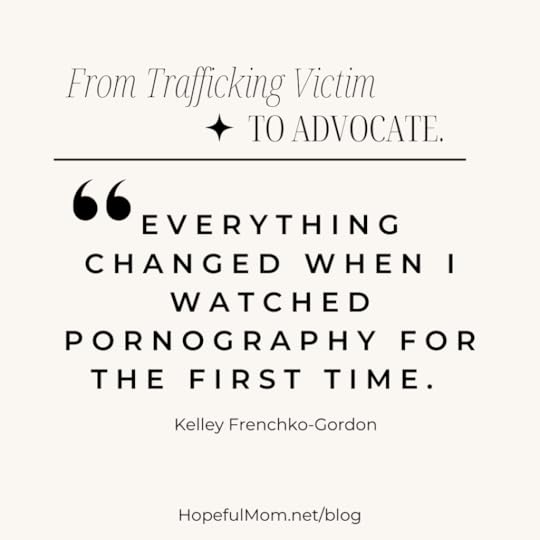
This honest belief led to a life of open sexuality, one that would keep me bound for more than twenty years. During that time, I experienced being drugged, raped, and videotaped. I was sixteen years old when I found out that the pornography videos were made and were circulating in my community. The story wasn’t that I was a trafficking victim. Instead, I was dubbed the “whore.”
Life went on, and I married into domestic violence, enduring eight years of secret abuse. When all of that ended, I turned towards the path that raised me. Drugs became my way of life, along with excessive drinking, and routine partying. That lifestyle quickly led to prostitution. After all, it was easy for me to enter back into the world I had become so familiar with. Only this time, I manipulated it for gain. My gain. No longer the innocent little girl, but the woman who made her body a god.
I first believed the lie that women were created for sex when I saw pornography. This belief led to a life of open sexuality. ~ Kelley Frenchko-Gordon #traffickingvictim #fightthenewdrug From Trafficking Victim to Advocate: Kelley’s…
Share on X
I’ve now been clean and sober thirteen years. I am married to Joseph, a man I never even hoped for, and we have two beautiful daughters. The dreams from the little girl I used to be have come to pass, with each sunrise bringing a renewed thankfulness. I often look back on the life I lived with a changed perspective, as if seeing with a different set of eyes.
I no longer think of myself as a trafficking victim; I’m a survivor and advocate.
Talk About Hard ThingsMy mission is to shed light on and bring conversation to the hard things. The sensitive subjects surrounding sex, drugs, rape, abuse, suicide, and the like. I believe there is a great responsibility placed on adults to talk about the things I wish I would have known about when I was younger. To be for them what I needed. In speaking with people of all ages, I have learned it’s easier and more comfortable to sweep things under the rug. To not go there. But coming from a place of experience, we must go there. We have to. Because the truth is: our children are.
We need to prepare our youth for what they will be or already have been exposed to. We want to keep them from becoming trafficking victims or any other type of victim. We must be a place of safety for them, allowing them into our lives and diving headfirst into theirs. Going all in…with no fear or turning back.
What We Can DoDiscuss the importance of boundaries, how to set them, and how to keep them. Explain that boundaries are healthy, and we should respect others’ boundaries just as we expect others to respect ours. When youth understand peer pressure and manipulation, they are empowered to resist it and say “no.”Instill confidence in them and encourage them to stick to their boundaries. Remind them of their future and explain how each decision they make now will affect the days to come.Ask challenging questions and open up conversations about red flags and the difference between healthy and unhealthy behaviors in relationships. You are raising awareness of verbal, sexual, and physical abuse.Again, I’ll say, our children must be prepared. It is necessary that we prepare them for the real world, releasing with them strength and assurance. Because I know now what I didn’t know then. And I know who I needed.
You are exactly who your child needs.
Subscribe for two FREE PDFs and updates. Check out other posts, visit the resources page and connect with Hopeful Mom on social media and through email.
The post From Trafficking Victim to Advocate: Kelley’s Journey of Triumph and Transformation appeared first on HOPEFUL MOM.
January 21, 2025
Choices That Lead to Your Best Life
Choices. We make them all day long. Should I have cereal or eggs for breakfast? Should I wear the black shoes or the navy? Should I brush my teeth today or not? . . . Wait! You don’t stop to think about that last one? . . . Come to think of it, neither do I. I automatically brush my teeth each and every morning. That’s a decision I made in middle school. A done deal. Or is it? While I concluded during my adolescent years that brushing my teeth daily is an absolute must, I can still walk away from this beneficial habit today if I want to. Hmmm. Nope. I think I’ll stick with it.
Big. Choices can be grandiose and life altering. Should I accept the promotion and move my family across the country? Do I choose the surgery which could eliminate the pain in my back but may paralyze me for life? We typically give these considerate thought, pondering the possible consequences. Although, life-altering ramifications may occur in an instant under certain circumstances. (i.e. Should I get behind the wheel of the car after three drinks?)
Small. Some choices seem insignificant. Can I spend a few more minutes perfecting this work project? Should I call my sibling, the one I haven’t talked to in a few weeks? Can I eat one more Oreo? How about one more episode on Netflix? The next generation may consider watching pornography to be a small, insignificant decision. The nonchalant societal attitude contributes to this viewpoint.
Unaware. And sometimes we don’t realize we’re making choices. It’s as if the decision finds us. Our choice is chosen before we think. The clock jumps forward half an hour while we innocently scroll reels. An empty bag of potato chips lays next to us. The vape pen empties itself. These subtle and subconscious deeds feel more like inevitabilities than choices. But, over time, they have the power and potential to steer our entire life in a direction we never intended to go.
People caught in addictions may find themselves in this position. They automatically reach for the substance that feeds their addiction before ever thinking about it.
What motivates each of these thousands of choices, deliberate or otherwise, each day? Brain science explains those habitual decisions, the ones we slide into without giving it an extra thought. However, our motivation should be more positive, more thought-provoked.
Living Our Best LifeWhen we’re in the classroom, my colleagues and I ask students, “Who wants to live your best life?” If they’re awake and paying attention, they typically raise their hands.
I can’t imagine too many people saying they don’t want to live their best life. But (1) what does living your best life mean? And (2) how do we get there? The second question’s simple answer is: Make healthy choices. (More on that in a minute.) The first question, however, may need some explanation, especially if we hope to talk with our children about living their best lives.
Because, as individuals, we each possess a different set of talents, skills, abilities, and personality traits, my best life differs greatly from yours. It’s not measurable. In other words, neither of us can look at the other and state, “You’re doing it.” This is a key point. As we march through time, we shouldn’t compare achievements, physical abilities, or disposition. A good reminder to pass along to our children.
Our best life is just that—ours.
To simplify, here’s a list which helps define living one’s best life:
You wake up feeling good about yourself.You wake up feeling good about your relationships—including the ones you have with yourself, God, and those around you.You look forward to your day, its activities and its outcomes.You can’t wait to interact with others—your friends, family, co-workers, and the community.You plan ahead with hopeful expectation.You’re optimistic about the future.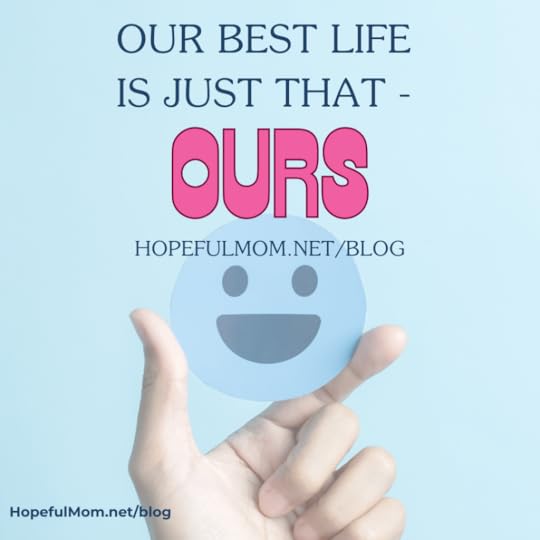
In order to live that best life, our goals and actions must align with our beliefs and values. Then we must make decisions, both big and small, that take us toward those goals and line up with our beliefs. Choices. Life-sustaining, life-giving choices which improve all aspects of our lives, positively influence others, and offer hope.
Yes, those small, subtle, subconscious actions can make a significant impact. Our current decisions affect the future. Each choice we make today moves us closer to our goals or farther away. Each helps us live our best life or makes it more complicated and chaotic. Joyful or depressed. Thriving or existing. Which road do we want to take? I hope your choices encompass your talents, skills, abilities, and personality traits. I hope they model your beliefs and values for your children. And, as you go, I hope you both live your best life. And that you keep brushing your teeth.
Please subscribe and share! Thank you!
The post Choices That Lead to Your Best Life appeared first on HOPEFUL MOM.



